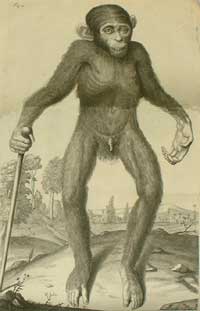Comparative anatomy

Comparative anatomy is the study of similarities and differences in the anatomy of different species. It is closely related to evolutionary biology and phylogeny[1] (the evolution of species).
Comparative anatomy has long served as evidence for evolution, now joined in that role by comparative genomics;[2] it indicates that various organisms share a common ancestor. Also, it assists scientists in classifying organisms based on similar characteristics of their anatomical structures. A common example of comparative anatomy is the similar bone structures in forelimbs of cats, whales, bats, and humans. All of these appendages consist of the same basic parts; yet, they serve completely different functions. The skeletal parts which form a structure used for swimming, such as a fin, would not be ideal to form a wing, which is better-suited for flight. One explanation for the forelimbs' similar composition is descent with modification. Through random mutations and natural selection, each organism's anatomical structures gradually adapted to suit their respective habitats.[3] The rules for development of special characteristics which differ significantly from general homology were listed by Karl Ernst von Baer (the Baer laws).



Three major concepts of comparative anatomy are:
- Homologous structures - structures (body parts/anatomy) which are similar in different species because the species have common descent. They may or may not perform the same function. An example is the forelimb structure shared by cats and whales.
- Analogous structures - structures similar in different organisms because, in convergent evolution, they evolved in a similar environment, rather than were inherited from a recent common ancestor. They usually serve the same or similar purposes. An example is the streamlined torpedo body shape of porpoises and sharks. So even though they evolved from different ancestors, porpoises and sharks developed analogous structures as a result of their evolution in the same aquatic environment.
- Homoplastic structures - structures that look similar, but are derived from convergent evolution, meaning that the two organisms displaying homoplasy do not share a common ancestor. Instead, they may have evolved in common environments and the traits arose due to natural selection.[4] This can be seen most prominently in species that have camouflage capabilities, like an insect that can look like a leaf, but has no photosynthetic capability.
History
The first specifically anatomical investigation separate from a surgical or medical procedure is associated by early commentators with Alcmaeon of Croton.[5] Pierre Belon, a French naturalist born in 1517, conducted research and held discussions on dolphin embryos as well as the comparisons between the skeletons of birds to the skeletons of humans. His research later led to what is referred to as modern comparative anatomy.

Around the same time, Andreas Vesalius was also making some strides of his own. A young anatomist of Flemish descent made famous by a penchant for amazing charts, he was systematically investigating and correcting the anatomical knowledge of the Greek physician Galen. He noticed that many of Galen's observations were not even based on actual humans. Instead, they were based on animals such as oxen. Up until that point, Galen and his teachings had been the authority on human anatomy. The irony is that Galen himself had emphasized the fact that one should make one's own observations instead of using those of another, but this advice was lost during the numerous translations of his work. As Vesalius began to uncover these mistakes, other physicians of the time began to trust their own observations more than those of Galen. An interesting observation made by some of these physicians was the presence of homologous structures in a wide variety of animals which included humans. These observations were later used by Darwin as he formed his theory of Natural Selection.[6]

Edward Tyson is regarded as the founder of comparative anatomy. He is credited with determining that marine mammals are, in fact, mammals. Also, he concluded that chimpanzees are more similar to humans than to monkeys because of their arms. Marco Aurelio Severino also compared various animals, including birds, in his Zootomia democritaea, one of the first works of comparative anatomy. In the 18th and 19th century, great anatomists like George Cuvier, Richard Owen and Thomas Henry Huxley revolutionized our understanding of the basic build and systematics of vertebrates, laying the foundation for Charles Darwin's work on evolution. An example of a 20th-century comparative anatomist is Victor Negus, who worked on the structure and evolution of the larynx. Until the advent of genetic techniques like DNA sequencing, comparative anatomy together with embryology were the primary tools for understanding phylogeny, as exemplified by the work of Alfred Romer.
Comparative anatomy is still taught, particularly in the field of paleontology.
See also
- Cladistics
- Evolutionary developmental biology
- Phylogenetics
- Transcendental anatomy
- Outline of biology#Anatomy
References
- ↑ Gaucher, Eric A.; Kratzer, James T.; Randall, Ryan N. (2010-01-01). "Deep Phylogeny—How a Tree Can Help Characterize Early Life on Earth". Cold Spring Harbor Perspectives in Biology. 2 (1): a002238. ISSN 1943-0264. PMC 2827910
 . PMID 20182607. doi:10.1101/cshperspect.a002238.
. PMID 20182607. doi:10.1101/cshperspect.a002238. - ↑ Hardison, R.C. (2003). "Comparative genomics". PLoS Biology. 1 (2): e58. PMC 261895
 . PMID 14624258. doi:10.1371/journal.pbio.0000058.
. PMID 14624258. doi:10.1371/journal.pbio.0000058. 
- ↑ Campbell, Neil A.; Reece, Jane B. (February 2002). Biology. San Francisco, CA: Benjamin Cummings. pp. 438–439.
- ↑ Kardong, Kenneth V. (2015). Vertebrates: Comparative Anatomy, Function, Evolution. New York: McGraw-Hill Education. pp. 15–16. ISBN 978-0-07-802302-6.
- ↑ Blits, K. C. (1999), Aristotle: Form, function, and comparative anatomy. Anat. Rec., 257: 58–63. doi: 10.1002/(SICI)1097-0185(19990415)257:2<58::AID-AR6>3.0.CO;2-I
- ↑ Caldwell, Roy (2006). "Comparative Anatomy: Andreas Vesalius". University of California Museum of Paleontology. Retrieved 2011-02-17.
Comparative Anatomy, pre-1800s
Bibliography
- Löw, Péter et al. (2016). Atlas of Animal Anatomy and Histology. Springer, .
- Wake, M.H. (ed.)(1979). Hyman's Comparative Vertebrate Anatomy. 3rd ed. University of Chicago Press, .
- Zboray, Géza et al. (2010). Atlas of comparative sectional anatomy of 6 invertebrates and 5 vertebrates. Wien: Springer, 295 p., .

